
Root pruning containers vs standard containers Illustration
Root pruning containers enhance plant growth by preventing root circling and promoting healthy root development through air pruning technology. Standard containers often lead to root-bound plants, restricting nutrient uptake and stunting growth. Choosing root pruning containers improves transplant success and long-term plant vitality.
Table of Comparison
| Feature | Root Pruning Containers | Standard Containers |
|---|---|---|
| Purpose | Control root growth to enhance plant health | General plant growth without root control |
| Root Growth | Air-pruning promotes dense root systems | Roots can become root-bound, circling |
| Material | Typically breathable fabric or slotted plastic | Solid plastic or ceramic |
| Plant Health | Improved nutrient absorption and stability | Risk of poor root development and stress |
| Water Drainage | Superior drainage reduces waterlogging | Variable drainage, often less effective |
| Longevity | Durable for repeated use with proper care | Varies, often prone to cracking or wear |
| Cost | Typically higher initial investment | Generally lower upfront cost |
Introduction to Root Pruning Containers
Root pruning containers are specially designed to promote healthier root systems by preventing root circling and encouraging root branching, unlike standard containers that often lead to tangled roots. These containers feature air-pruning holes or mesh sides that naturally trim root tips when they reach the container edges, stimulating the growth of finer, more fibrous roots. Improved root architecture enhances nutrient uptake, plant stability, and overall growth performance compared to traditional solid-walled containers.
Understanding Standard Gardening Containers
Standard gardening containers are typically designed with basic drainage holes and smooth walls, allowing for easy root growth but limited control over root direction, which can lead to root circling and poor plant health. These containers are made from materials like plastic, ceramic, or terracotta that vary in breathability, impacting moisture retention and aeration. Compared to root pruning containers, standard containers lack specialized features such as air pruning surfaces or internal root barriers that actively promote healthier, more fibrous root systems.
How Root Pruning Containers Work
Root pruning containers feature a unique design with tapered or ridged walls that air-prune roots when they reach the container edges, preventing root circling and promoting a dense, fibrous root system. This air exposure dehydrates the root tips, stimulating the growth of new lateral roots and enhancing overall plant health and nutrient uptake. Unlike standard containers, which often lead to root binding and reduced transplant success, root pruning containers improve root structure and encourage vigorous plant development.
Benefits of Root Pruning in Container Gardening
Root pruning containers enhance plant health by preventing root circling and promoting a dense, fibrous root system that improves nutrient and water uptake. These containers encourage vigorous growth and reduce transplant shock by stimulating root branching and airflow around roots. Compared to standard containers, root pruning containers support longer plant longevity and better overall development in container gardening.
Limitations of Standard Containers for Root Growth
Standard containers often restrict root growth due to their limited space and lack of specialized design, leading to root circling and poor aeration. This restriction can cause stunted plant development and reduced nutrient uptake efficiency. Root pruning containers enhance root health by promoting natural root branching and preventing root bound conditions common in standard containers.
Comparing Plant Health: Root Pruning vs Standard Containers
Root pruning containers enhance plant health by preventing root circling and promoting a dense, fibrous root system, which improves nutrient uptake and overall growth. Standard containers often lead to root-bound plants with circling roots that limit water absorption and stunt development. By encouraging healthier root architecture, root pruning containers reduce transplant shock and increase plant resilience.
Watering and Nutrient Management in Different Containers
Root pruning containers enhance water and nutrient uptake by promoting dense, fibrous roots that prevent circling and improve absorption efficiency compared to standard containers. These containers reduce excess water retention and nutrient leaching, ensuring more precise management and healthier plant growth. Standard containers often cause uneven root distribution, leading to inconsistent watering needs and potential nutrient deficiencies.
Ideal Plants for Root Pruning Containers
Root pruning containers are ideal for plants with aggressive root systems like fruit trees, tomatoes, and shrubs, promoting healthier root growth and preventing root circling. These containers benefit species such as citrus trees, blueberries, and certain perennials that require controlled root expansion for optimal nutrient uptake. Standard containers suit plants with less vigorous roots but often cause root binding in high-demand species that thrive better in root pruning designs.
Cost and Accessibility Comparison
Root pruning containers typically cost more upfront due to specialized design features that encourage healthy root growth and reduce transplant shock. Standard containers are generally more affordable and widely accessible through various retail channels, making them a popular choice for casual gardeners. While root pruning containers may require a higher initial investment, their long-term benefits can offset costs by promoting stronger plant development and reducing replacement frequency.
Choosing the Right Container for Your Garden
Root pruning containers promote healthier plant growth by encouraging a dense, fibrous root system that prevents circling and root-bound issues common in standard containers. Selecting root pruning containers enhances nutrient uptake and water absorption, supporting stronger, more resilient plants in your garden. Opting for these specialized containers ensures optimal root development, particularly for trees and shrubs, leading to improved overall plant health and increased growth efficiency.
Root pruning containers vs standard containers Infographic

 gardendif.com
gardendif.com